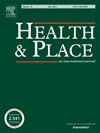儿童长臂的地理变异。
IF 3.8
2区 医学
Q1 PUBLIC, ENVIRONMENTAL & OCCUPATIONAL HEALTH
引用次数: 0
摘要
学者们已经记录了童年社会经济地位(SES)对健康的持久影响,但很少有研究考虑童年时期的社会经济地位如何在整个生命过程中塑造基于童年社会经济地位的健康轨迹。目前的项目使用来自2009-2021年收入动态小组研究的数据(N = 18,227名18-41岁成年人的年观察数据),通过以下方式建立这些研究:1)检查儿童SES与成人自评健康之间关系的州差异,以及2)评估儿童州一级经济背景在调节这种关系方面的贡献。Logistic回归模型首次证实了儿童SES与成人自评健康之间的预期关系,与其他文献相似(OR = 1.79, 95% CI 1.46, 2.19)。在纳入分析的37个州中,有14个州的儿童社会经济地位低和高的群体在报告健康状况不佳方面存在统计学上的显著差异。儿童期社会经济地位与州一级收入不平等之间的相互作用(OR = 0.01, 95% CI -9.77, - 0.62)表明,儿童期暴露于较高水平的收入不平等对社会经济地位较高的个体的健康更有害。儿童期社会经济地位与失业率之间的相互作用(OR = 1.13, 95% CI 1.03, 1.24)表明,儿童期暴露于较高的失业率对社会经济地位较低的个体的健康更有害。本研究发现,儿童社会经济地位与成人健康之间的关系存在重要的状态差异,并确定收入不平等和失业率是这些差异的因素。本文章由计算机程序翻译,如有差异,请以英文原文为准。
Geographical variation in the long-arm of childhood
Scholars have documented the lasting impact of childhood socioeconomic status (SES) on health, but few studies have considered how state contexts in childhood shape health trajectories based on childhood SES across the life course. The current project uses data from the Panel Study of Income Dynamics, 2009–2021 (N = 18,227 person-year observations of adults aged 18–41) to build on these studies by 1) examining state variation in the relationship between childhood SES and adult self-rated health, and 2) assessing the contributions of childhood state-level economic context in moderating this relationship. Logistic regression models first confirmed the expected relationship between childhood SES and adult self-rated health that parallels other literature (OR = 1.79, 95% CI 1.46, 2.19). Of the 37 states included in the analysis, there was a statistically significant difference in reporting poor health between low and high-childhood SES groups in 14 states. The interaction between childhood SES and state-level income inequality (OR = .01, 95% CI -9.77, −.62), suggests that exposure to higher levels of income inequality in childhood was more harmful for the health of individuals from higher SES backgrounds. The interaction between childhood SES and unemployment rates (OR = 1.13, 95% CI 1.03, 1.24), suggests that exposure to higher unemployment rates in childhood was more harmful for the health of individuals from lower SES backgrounds. This study finds important state-variation in the relationship between childhood SES and adult health and identifies income inequality and unemployment rates as factors in these differences.
求助全文
通过发布文献求助,成功后即可免费获取论文全文。
去求助
来源期刊

Health & Place
PUBLIC, ENVIRONMENTAL & OCCUPATIONAL HEALTH-
CiteScore
7.70
自引率
6.20%
发文量
176
审稿时长
29 days
期刊介绍:
he journal is an interdisciplinary journal dedicated to the study of all aspects of health and health care in which place or location matters.
 求助内容:
求助内容: 应助结果提醒方式:
应助结果提醒方式:


